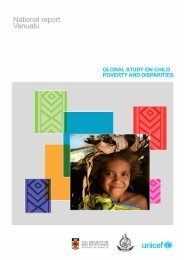A Strategic Assessment of the Children's Services Industry
A Strategic Assessment of the Children's Services Industry
A Strategic Assessment of the Children's Services Industry
- No tags were found...
You also want an ePaper? Increase the reach of your titles
YUMPU automatically turns print PDFs into web optimized ePapers that Google loves.
STRATEGIC ASSESSMENT OF THE CHILDREN’S SERVICES INDUSTRY… children who attended local authority day nurseries and private day nurseriesshow poorer behavioural outcomes than those who attended o<strong>the</strong>r forms <strong>of</strong>provision. Moreover children who attended integrated provision or nursery classestended to make greater gains in social/behavioural development during <strong>the</strong>preschool period. None<strong>the</strong>less, <strong>the</strong>re was significant variation in effectiveness onsocial/behavioural gains within each type <strong>of</strong> provision; thus differences betweenindividual preschool centres and differences between types <strong>of</strong> provision are bothimportant 5 (Sylva et al. 2004, 31).These findings, as <strong>the</strong> EPPE team noted, were similar to those found by <strong>the</strong> UK Office forStandards in Education (OfSTED) which reported on variations in <strong>the</strong> quality <strong>of</strong> preschoolprovision across sectors. Similar results were found in a study using ECERS in 44 preschoolcentres in London (Lera, Owen and Moss 1996).This finding was also expanded upon in a report <strong>of</strong> quality in <strong>the</strong> Millennium Cohort Study:Local Education Authority (LEA) maintained status was linked to higher qualityprovision in almost all dimensions measured, with <strong>the</strong> exception <strong>of</strong> provision forpersonal care routines. Maintained settings <strong>of</strong>fered higher quality interactions,provision for children’s developing language and reasoning skills, and highercurricular quality for literacy, maths, science and diversity. The relationships with‘interactions’ and ‘maths’ were only apparent when staff qualifications wereremoved from <strong>the</strong> regression model. This suggests that staff qualification may beone <strong>of</strong> <strong>the</strong> main factors driving <strong>the</strong> higher quality achieved by <strong>the</strong> maintainedsector in <strong>the</strong>se areas (Ma<strong>the</strong>rs, Sylva and Joshi 2007, 8).How relevant are <strong>the</strong>se findings to Australian conditions? There are no large-scale systematic,Australian studies that allow us to test <strong>the</strong>se finding in <strong>the</strong> local context. However, <strong>the</strong> smallscalestudies conducted in Australia are consistent with international research. In 2006, <strong>the</strong>Australia Institute conducted a mail-out survey <strong>of</strong> staff working in long day care acrossAustralia with <strong>the</strong> aim <strong>of</strong> eliciting staff perceptions about <strong>the</strong> quality <strong>of</strong> care in <strong>the</strong> centres inwhich <strong>the</strong>y work. The Institute drew a random, stratified sample reflecting <strong>the</strong> proportion <strong>of</strong>long day care centres between <strong>the</strong> States and <strong>the</strong> approximate balance between metropolitanand regional locations in each State. The sample matched <strong>the</strong> distribution <strong>of</strong> service types(community-based, independent private and corporate chain) across Australia (Rush 2006,24). The response rate to <strong>the</strong> survey was 15 per cent, which is considered relatively low.However, at least one valid response was received from a staff member at 45 per cent <strong>of</strong> <strong>the</strong>centres to which questionnaires were sent which adds a measure <strong>of</strong> confidence. Never<strong>the</strong>less,it is appropriate to regard <strong>the</strong> findings <strong>of</strong> <strong>the</strong> Australia Institute survey as indicative ra<strong>the</strong>rthan conclusive.The survey confirmed <strong>the</strong> widely held view that <strong>the</strong>re is great diversity in <strong>the</strong> quality <strong>of</strong> careprovided in Australian long day care settings. Some staff from all three service types reportedthat <strong>the</strong>ir centre provided high quality care. In aggregate terms, <strong>the</strong>re were clear trends instaff perceptions <strong>of</strong> quality. On a number <strong>of</strong> key measures, <strong>the</strong> perceptions <strong>of</strong> staff employedin community-based centres and <strong>the</strong> perceptions <strong>of</strong> staff working in independently ownedprivate services clustered toge<strong>the</strong>r at <strong>the</strong> higher quality end <strong>of</strong> <strong>the</strong> spectrum. Staff working in5 The study also noted that proportionately more <strong>of</strong> <strong>the</strong> children in local authority day nurseries and private daynurseries started at <strong>the</strong>ir preschool centre before 2 years <strong>of</strong> age.38
















